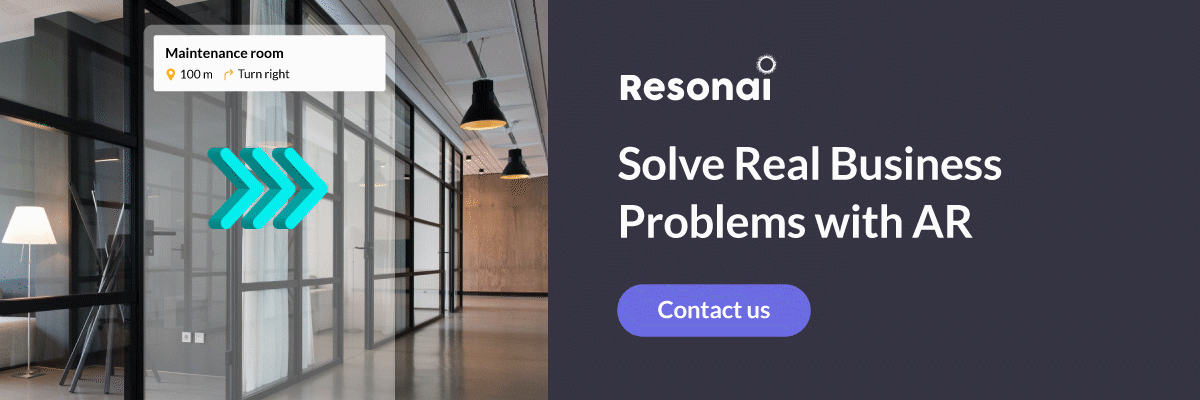How AR Can Maximize the Value of a Lean Facilities Management Staff
Even with smaller teams and tighter budgets brought on by a global crisis, AR tech can help you do more with less.

The COVID-19 outbreak has put a strain on the global economy, and as a result, many businesses are scrambling to do more with less. In the facilities management industry, teams are leaner than ever before, and person-to-person contact is an untenable risk. In a field that typically requires on-site, hands-on work, it’s especially difficult to keep productivity and efficiency up. But could modern technology help address these challenges?
In this article, we’ll explore some ways that augmented reality can make life easier. AR has numerous benefits that make it a natural fit for facilities managers — especially if deployed as a part of a unified platform, equipped with AI and IoT technology. Let’s dig in!
#1: AR training
With a leaner staff, getting employees up to speed efficiently is more vital than ever before. However, traditional training can be a slow process — and just think of how long it takes to make changes to a standard employee manual.
AR training is the answer. It’s much quicker (and cheaper!) to update and deploy new content, and staff can complete the training independently, without person-to-person contact. Content can be uploaded remotely and used to onboard managers, cleaning staff, maintenance workers, and everyone in between.
Time savings isn’t the only benefit of AR training. Trainees also receive an engaging, personalized experience, superior to that of traditional mediums. Context-based 3D visualizations are hugely beneficial in almost any industry. Just ask Finn Faldi, President of TeamViewer Americas, who said of his company’s AR training programs, “AR enables immersive training without leaving the workplace, it provides new ways for trainers to illustrate, demonstrate, and explain. It is well documented that hands-on learning is more effective for many learners. After completing a task guided by AR (or a combination of AR and expert), trainees are much more likely to recall the necessary steps the next time they perform the task.”
According to research firm Forrester, “Engaged employees spend more time than their colleagues trying to improve their work performance through learning and deliberate development.” This comprehensive, engaging training medium will get up staff up to speed more quickly and keep them motivated long after it ends.
#2: AR for maintenance services
As Benjamin Franklin once said, “An ounce of prevention is worth a pound of cure.” This quote still rings true, especially when it comes to maintenance. Preventive maintenance typically reduces downtime by 30% to 50%, saving both time and money. Technology plays a huge role in preventive maintenance, allowing facilities management companies to address issues before they become a problem.
IoT sensors and AI engines can improve maintenance alerts and predict issues in their nascency. Meanwhile, AR can streamline the maintenance process, providing step-by-step instructions for repairs through your team’s mobile devices. The same interface can help staff navigate buildings through AR-enabled wayfinding. Such features will allow a lean team to manage maintenance tickets across a wider network of properties.
These technologies also streamline communications and improve the tenant experience. With the right AR application, tenants can use intelligent ticketing to flag issues as they arise, and even upload visuals to make the process quicker for maintenance pros.
#3: AR for remote work
Facilities management is typically not synonymous with remote work. Traditionally, managers, maintenance staff, and cleaners will all work onsite to monitor building health, respond to tenant inquiries, and manage general upkeep. However, the need for social distancing has resulted in many industries rethinking what can be done from afar, and facilities management is no exception.
An AR-enabled platform will provide a centralized hub for managing every aspect of the building, even from afar. Digital twins technology provides accurate 3D visuals of any space, allowing you to monitor usage patterns dynamically. You can then leverage the data generated from every application to optimize workflows.
AR also makes social distancing more tenable for on-the-ground workers. IoT devices can be controlled straight through the AR platform, rather than through physical buttons. Similarly, cleaning staff can perform hygiene checks based on which spaces see recorded usage.
Facilities management for the modern age
Even before 2020, AR technology was already transforming the way facilities management companies did business. The pandemic and economic fallout have only heightened the need for more advanced, efficient processes throughout the industry. With the right AR platform, you’ll be able to get the most out of your team and budget for years to come.
At Resonai, we had facilities management in mind when creating Vera, our AI platform that turns physical buildings into intelligent digital spaces. With Vera, facilities managers can navigate 2020’s many challenges while implementing an infrastructure that will increase efficiency and reduce costs for years to come.
Ready to learn more? Get in touch to set up a demo.
Subscribe to Our Newsletter!
Read More
How Vera Helped Moscow Trade Center Reduce Repair Times By 44%
Every day, tens of thousands of buyers visit Moscow Trade Center, one of the world’s largest...
How to Get the Most Out of Smart Building Upgrades
Building management is a costly, time-consuming endeavor. With routine maintenance, tenant...
Majority of Facility Managers Expect to Adopt AR in the Next 2 Years
Augmented reality is becoming a crucial component of facilities management, according to our new ...
